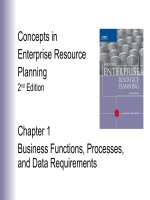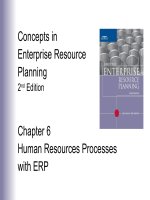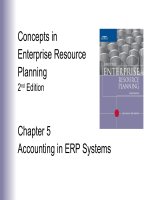Lecture concepts in enterprise resource planning (2nd edition) chapter 5 accounting in ERP systems
Bạn đang xem bản rút gọn của tài liệu. Xem và tải ngay bản đầy đủ của tài liệu tại đây (319.2 KB, 51 trang )
Concepts in
Enterprise Resource
Planning
2nd Edition
Chapter 5
Accounting in ERP Systems
Chapter Objectives
• Describe the differences between financial and
managerial accounting .
• Identify and describe problems associated with
accounting and financial reporting in un-integrated
information systems.
• Describe how ERP systems can help solve accounting
and financial reporting problems in an un-integrated
system.
• Describe how the Enron scandal and the SarbanesOxley Act will affect accounting information systems
• Explain accounting and management-reporting benefits
that accrue from having an ERP system.
Concepts in Enterprise Resource Planning, Second Edition
2
Introduction
• Accounting is a functional area that is tightly integrated
with other functional areas like:
• Marketing and Sales
• Supply Chain Management
• Accounting activities are necessary for decision making
Concepts in Enterprise Resource Planning, Second Edition
3
Types of Accounting
• Firms require three types of accounting activities
• Financial Accounting
• Documents all transactions that have an impact on
the firm
• Uses this transaction data to make external reports
for various agencies (FASB, SEC, IRS)
• Managerial Accounting
• Determine costs and profitability of a company’s
activities
• Managerial Information is used for planning and to
control a company’s day-to-day activities
• Tax Accounting is a specialized field that used
Financial Accounting information
Concepts in Enterprise Resource Planning, Second Edition
4
Financial Accounting
• Common Financial Accounting statements include:
• Balance Sheet
• Shows account balances at a particular point in
time
• Gives a good picture of the overall financial health
of a company
• Income Statement
• Shows sales, cost of sales and overall profit for a
period of time (quarter, year)
Concepts in Enterprise Resource Planning, Second Edition
5
Figure 5.1 Fitter Snacker sample balance sheet
Concepts in Enterprise Resource Planning, Second Edition
6
Figure 5.2 Fitter Snacker sample income statement
Concepts in Enterprise Resource Planning, Second Edition
7
ERP for Accounting Information
• Early information systems gathered data primarily for
their own functional area (sales, production, payroll, etc.)
• Data sharing with accounting did not occur in “real time”
• Accountants and functional area clerks frequently had to
do significant research to gather the data needed for
reports
• ERP systems, with centralized databases, avoid these
problems
• Materials Management module sees a goods receipt
as an increase in inventory
• Accounting module sees goods receipt as an increase
in the value of inventory
• A single data entry transaction provides the data
for both
Concepts in Enterprise Resource Planning, Second Edition
8
General Ledger
• A company’s accounts are kept in the general ledger
• In SAP R/3, input to the general ledger occurs
simultaneously with the business transaction in the
functional module
• Sales and Distribution (SD)
• Sales to customers create accounts receivable
entries
• Materials Management (MM)
• Purchase orders create accounts payable entries
• Human Resources (HR)
• Payroll processing creates expense entries
Concepts in Enterprise Resource Planning, Second Edition
9
General Ledger
• Other modules also create general ledger entries
• Financial Accounting (FI)
• Manages the accounts receivable and accounts
payable items created in SD and MM
• Module where general ledger accounts are closed
at the end of a fiscal period
• Controlling (CO)
• Tracks the costs associated with producing
products
• Asset Management (AM)
• Manage fixed-asset purchases (plant, machinery,
etc.) and associated depreciation
Concepts in Enterprise Resource Planning, Second Edition
10
Operational Decision Making Problem:
Credit Management
• A company with an un-integrated information system can
have accounting data that is out-of-date or inaccurate
• Out-of-date or inaccurate data can lead to bad
operational decisions
• Fitter Snacker has this problem with credit management
• Companies routinely sell to customers on credit
• Sound credit management gives customers enough
credit to promote sales while minimizing the risk from
default
• Making the correct credit management decision requires
accurate and timely sales and payment data
Concepts in Enterprise Resource Planning, Second Edition
11
Operational Decision Making Problem:
Credit Management
• At Fitter Snacker:
• The sales clerk uses a weekly printout of all customer
balances and credit limit to see if credit should be
granted for a new order
• Sales data are transmitted to accounting 3 times per
week
• Both sales and accounting work off data that is not
real-time and may be more than a week old
• Customer orders that would bring them over
the credit limit may be accepted
• Customers may be denied credit because
recent payments are not available to the sales
clerk
Concepts in Enterprise Resource Planning, Second Edition
12
Credit Management in SAP R/3
• SAP R/3 allows for a number of configuration options to
determine how the system responds to an order that
would cause a customer to exceed its credit limit
• The system may block the sales order
• The system may prevent the sales order from being
saved
• The system may issue warning messages to the sales
order clerk
• Credit is a sensitive issue, so the system response must
be configured to match a company’s procedures
• Typically, sales orders are blocked, with no warning given
to the sales order clerk
• A credit specialist would regularly review blocked
orders and take corrective action
Concepts in Enterprise Resource Planning, Second Edition
13
Dynamic
credit
check
Only orders for
the next two
months are
considered
Reaction C: warning
message is issued
when order is saved
Figure 5.3 Credit management configuration
Concepts in Enterprise Resource Planning, Second Edition
14
Credit limit for Health Express
Outstanding
obligations
Figure 5.4 Credit management for Health Express
Concepts in Enterprise Resource Planning, Second Edition
15
Options to release, reject or
forward blocked sales orders
Figure 5.5 Blocked sales order
Concepts in Enterprise Resource Planning, Second Edition
16
Product Profitability Analysis
• Accounting data is used to determine the profitability of a
company and its products
• Inaccurate and/or incomplete data can lead to a
flawed analysis
• The three main causes of data problems are:
• Inconsistent record keeping
• Inaccurate inventory costing
• Problems consolidating data from subsidiaries
Concepts in Enterprise Resource Planning, Second Edition
17
Inconsistent Record Keeping
• At Fitter Snacker:
• Sales data is not maintained so that sales reports are
easily generated
• Analyzing sales data by region or division usually
must be done by hand
• Production data is maintained with paper records
• Data must be typed into a spreadsheet from paper
records before it can be analyzed
• Manual entry leads to errors
• Without an integrated information system, much of
the effort in generating reports is devoted to working
around the limitations of the systems
Concepts in Enterprise Resource Planning, Second Edition
18
Inaccurate Inventory-Costing Systems
• Correctly calculating inventory costs is an important and
challenging task in any manufacturing company
• A manufactured item’s cost has three elements:
• Cost of raw materials used in the item
• Labor used specifically to produce the product (direct
labor)
• Overhead: all other costs
• Factory utilities
• General factory labor (custodial services, security)
• Manager’s salaries
• Storage
• Insurance
Concepts in Enterprise Resource Planning, Second Edition
19
Direct and Indirect Costs
• Materials and labor are called direct costs
• Direct costs are relatively easy to tie to the production
of specific products
• Overhead is an indirect cost
• Indirect costs are difficulty to associate with a specific
product
• e.g. the relationship between the cost of heating
and lighting and a specific batch of NRG-A bars
• To determine the cost of a manufactured product,
indirect costs must be allocated to products
Concepts in Enterprise Resource Planning, Second Edition
20
Direct and Indirect Costs
• Allocating indirect costs
• One method is to use total machine hours
• Total overhead cost divided by the total
machine production time (hours) available for a
period to get an overhead rate per machine
hour
• Example:
• Overhead costs per month: $152,500
• Production line capacity: 50 cases/hour
160 hours/month
$152,000 / mo.
= $950 / hour
160 hour/mo.
$950 / hour
= $19 / case
50 case/hour
Concepts in Enterprise Resource Planning, Second Edition
21
Direct and Indirect Costs
• Allocating indirect costs
• Another method is to use direct labor hours
• The assumption with this method is that
overhead costs are incurred so workers can do
their jobs
• For Fitter Snacker, the snack bar bake line is the
fundamental production process as well as
capacity constraint, so allocating indirect costs
using machine hours (snack bar bake line hours)
would make sense
Concepts in Enterprise Resource Planning, Second Edition
22
Standard Costs
• Costs are typically recorded using standard costs, which
are based on historical cost data
• At the end of an accounting period, adjustments to
accounts must be made as actual costs will differ from
estimates made using standard costs
• Balance sheet: cost of inventory held will need to be
adjusted
• Income statement: cost of goods sold will have to be
adjusted
• Difference between actual costs and standard costs are
called cost variances
• Cost variances arise with both direct and indirect costs
Concepts in Enterprise Resource Planning, Second Edition
23
Activity-Based Costing (ABC)
• In ABC, records are kept on overhead costs and the
activities associated with overhead cost generation
• The goal is to more precisely associate costs with the
causes (drivers) and avoid rough allocation procedures
• Profitability of particular products is more accurately
determined
• ABC is often used when:
• Competition is stiff
• Overhead costs are high
• Products are diverse
• Not all overhead costs can be linked to activities
Concepts in Enterprise Resource Planning, Second Edition
24
Activity-Based Costing (ABC)
• ABC requires more bookkeeping than traditional costaccounting approaches
• ABC is often used for strategic purposes in parallel with
standard cost accounting
• A recent study noted that:
• ERP companies had nearly twice as many costallocation bases to use in management decisionmaking
• ERP companies’ managers rated their costaccounting system much higher
Concepts in Enterprise Resource Planning, Second Edition
25









